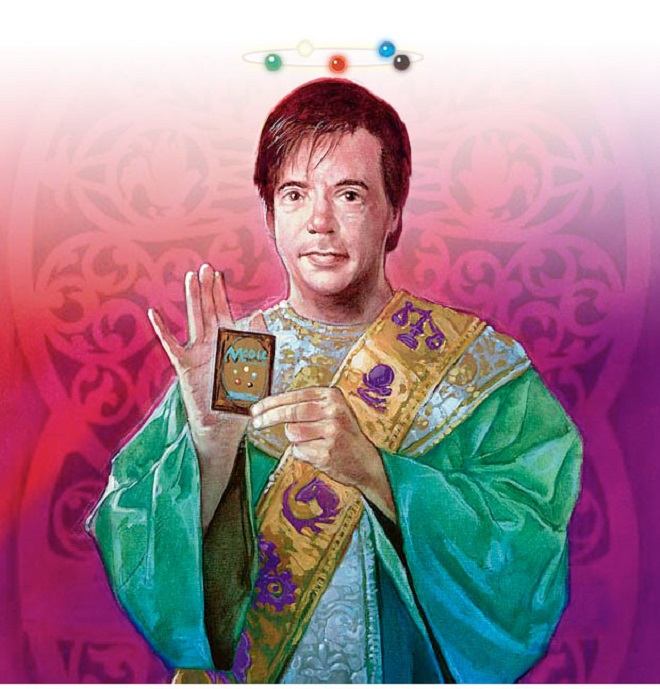For most people, earning a PhD from an Ivy League institution would be the highlight of a decade.
For Richard Garfield, it wasn’t even the biggest thing he did that year.
In 1993, Richard Garfield finished a dissertation on combinatorial mathematics at the University of Pennsylvania and moved cross-country to teach at Whitman College in Walla Walla, Washington. Also in 1993, he published his first professionally produced game. That game was Magic: The Gathering, and it not only became a success, it launched a new genre of game, the Trading Card Game or TCG (sometimes called “collectable card game” or CCG).
A Lifelong Love of Games
From an early age, Garfield enjoyed games. It was not until he discovered Dungeons & Dragons, however, that his enjoyment turned into a passion for them. Dungeons & Dragons led him to make serious studies of games and how they worked. Being a professional game designer, however, seemed like a pipe dream. As he told Tom Vasel of The Dice Tower: “By the time I was in college I had come to the conclusion that game design was not the place to stake out a career. After all, each day in the newspaper there were movie reviews and bestseller lists, but hardly anything about games. If games weren’t even big enough to get a bestseller list or review in the paper once a year, it must be pretty small potatoes.”
Instead, Garfield pursued an academic career in mathematics, with an emphasis on combinatorics, a field which has origins in and close links to the games he loved. He did not, however, stop discovering new games. In Cosmic Encounter, for example, he found a board game that had seemingly endless replay value from a variety of factions to play as that all broke the game’s rules in their own ways.
He did not stop designing new games, either. In 1982, inspired by Cosmic Encounter, Garfield developed Five Magics, which applied the rule-breaking principle to a card game. And in 1985, he largely completed the design for a board game, RoboRally, which proved popular with his friends, including, most crucially, Mike Davis.
A Fateful Meeting
Richard Garfield originally was reluctant to seek professional publication of RoboRally, but Davis believed in its potential. They made a deal to become partners on selling RoboRally, so long as Davis handled all business negotiations.
After things didn’t work out with several large publishers, Davis approached Peter Adkison, who led a small startup game publisher called Wizards of the Coast. Garfield, Davis, and Adkison eventually met in Oregon in the summer of 1991, where Adkison gave Garfield and Davis good news and bad news: while Adkison loved RoboRally, Wizards of the Coast did not have the resources to publish the complex game.
Adkison had a clear idea, however, of what he did want: an easy-to-produce game that would fit between sessions of role-playing games. That one request would spark a game movement 30 years old and counting.
It All Comes Together
Garfield spent the next several days hiking and thinking about Adkison’s request. Influences from Cosmic Encounter and the decades-old Strat-O-Matic Baseball merged with Garfield’s unpublished designs, including Five Magics and a card game called Safecracker, to create the TCG.
When Garfield told Adkison his game idea, Adkison was ecstatic. As Adkison recounted in a post made on USENET in January 1993, “… I knew at that moment that we had an idea that would add a whole new dimension to gaming, and if executed properly, would make us millions. This wasn’t just a new game, it was a new gaming form.”
Testing, Testing
To make good on the “if executed properly” part, Garfield took the game concept back to the University of Pennsylvania, where his friends and fellow students became his playtesters; the first game of what would become Magic: The Gathering was between Garfield and Barry “Bit” Reich, then a computer science student. The game went through several iterations before reaching its first published form, and the cards used by the playtesters evolved similarly, from simple hand-drawn cards to card stock with clip art.
During this time, Garfield was juggling game design with what he thought would be his future in academia. He defended his thesis, becoming Richard Garfield, Ph.D. in the process, and accepted his first teaching position as a visiting professor at Whitman College in Walla Walla, Washington. But between the end of his studies and his first class on the West Coast, Magic: The Gathering debuted at Gen Con on August 5, 1993.
Success and Its Consequences
Magic: The Gathering was an instant success, selling out at Gen Con and going through multiple printings (today called Limited Edition Alpha, Limited Edition Beta, and Unlimited) before the end of 1993. The playtesting group Garfield left behind at the University of Pennsylvania continued to develop and playtest cards for future Magic: The Gathering sets. Several of them later joined Wizards of the Coast as employees, and the high-ranking leadership of Wizards of the Coast includes multiple members of that original playtesting group.
As for Garfield himself, after his first year as a mathematics professor, he faced the choice of whether to continue with academia or take the leap into becoming a full-time game designer. He chose the latter course, and has since designed or co-designed more than 30 published games in addition to his work, both in-house and later freelance, as a Magic: The Gathering designer.
The first of those games? RoboRally. Wizards of the Coast, no longer quite so crunched for resources, released the game in 1994, and still markets it under its Avalon Hill brand.


